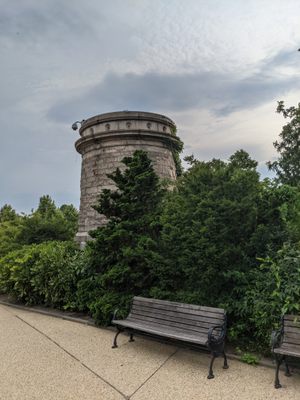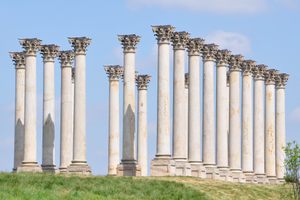About
There are two unmarked stone towers on the western slope of the Capitol Grounds. Overshadowed by the Capitol dome and downplayed by blocking shrubbery, most people walk by without noticing them.
These are the end caps for two massive air ducts leading 400 feet up into the belly of the Capitol. You can see the 15-foot-wide passageways marked here in a 1961 map. The asymmetry of their layout corresponds to differences in elevation on the House and Senate side of the hill.
The air ducts date to 1928 and were part of an engineering effort to install air conditioning in the Capitol. Summer in Washington is notoriously muggy, and this unpleasantness was amplified in the crowded and windowless legislative chambers. Some Members of Congress took this really, really seriously.
The House of Representatives Historian notes:
By 1928, Members of Congress were genuinely concerned about their ability to work under such conditions. Several Representatives announced that 202 of their colleagues had died in office in the previous 35 years, and suggested unhealthful air in the House Chamber as a contributing cause. A study of the Capitol’s ventilation was commissioned and recommended air conditioning the chamber. The House jumped at the prospect. In May a call went out for a new system, and within months the Carrier Corporation had designed and installed its “Manufactured Weather,” with air that would “guard the Health, assure the Comfort and inspire the Achievement of the Nation’s representatives.”
The Senate watched this with envy and quickly moved to install their own AC system. Posted notices served to reassure elderly Senators that the cool air was nothing to be frightened of.
The system worked by drawing in air from the towers on the Western Front park. A fan the size of a ship's propeller blasted the air through a dense radiator-like array of pipes containing cold water. Then it passed through the humidifier room where a spray of water restored an appropriate level of moisture. Thence, up into the Senate and House, where it entered the chambers through grates in the floors.
The Carrier Corporation—perhaps excessively—predicted that the AC would have "a profound effect upon our governmental system! Congress may voluntarily remain in session throughout the summer, in order that our Congressmen may be protected from the intolerable discomforts and dangers of the ordinary outdoor weather!”
Those air duct towers deserve a plaque befitting their impact on our great democracy.
Related Tags
Know Before You Go
You can view the air conditioning towers on the west side of the Capitol building.
These are not open to the public. However, they are still in use. Because of their efficiency at drawing in such a large amount of regulated, cool air, they are still used today, in conjunction with a modern air conditioning system. The draw of air is so strong, that they actually affect the Capitol buildings air pressure. When you pull open either the House, or Senate doors, (that lead outside), the air pressure is so strong, that it helps pull the doors closed. This is helpful because there is a lot of fragile, temperature, and humidity sensitive artwork in the Capitol, that needs to be preserved.
Community Contributors
Added By
Published
January 6, 2017
















































